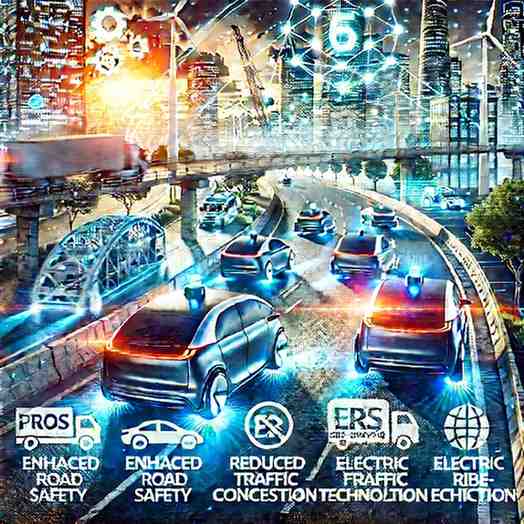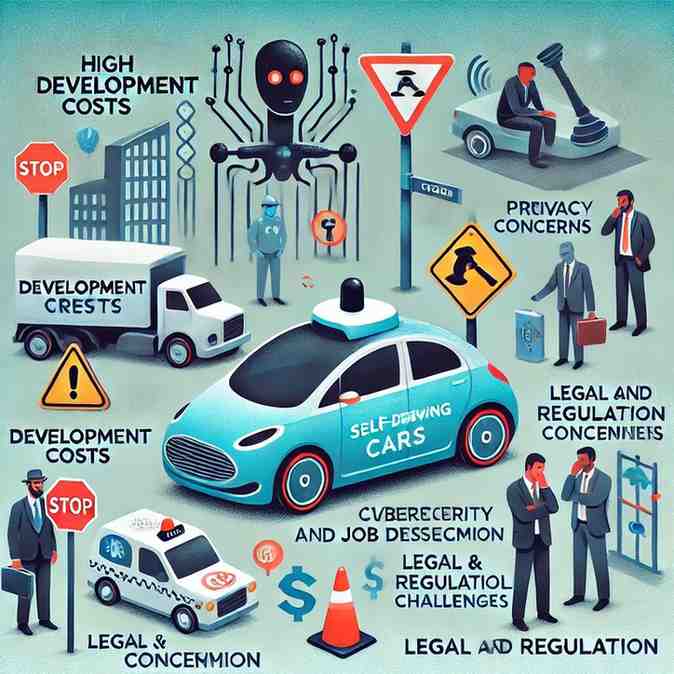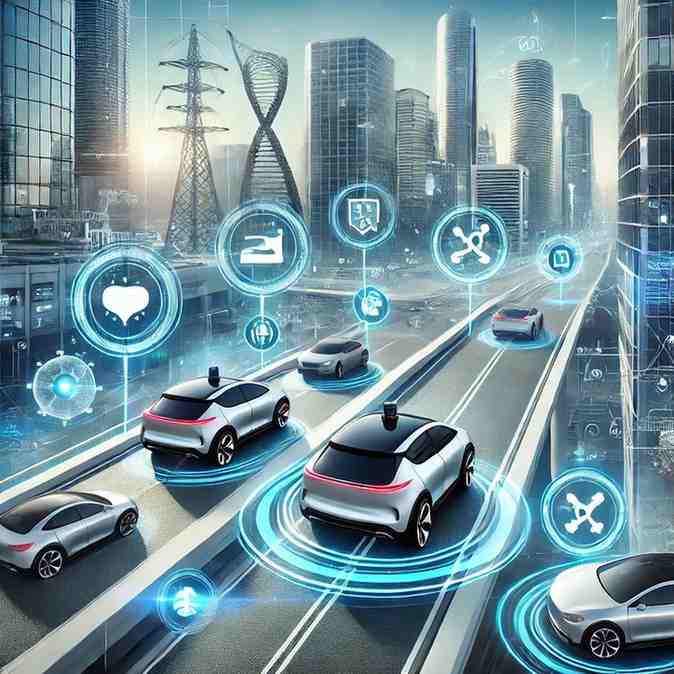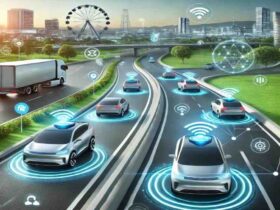This article delves into driverless vehicles the pros and corns of self driving cars, highlighting their potential impacts on daily life, the environment, and society at large. In recent years, driverless vehicles, also known as self driving cars, have garnered considerable attention due to rapid technological advancements.
These autonomous vehicles promise to revolutionize the transportation industry with their cutting-edge features and futuristic capabilities. However, with every technological innovation, there are both advantages and challenges to consider.
Understanding Self Driving Cars: What Are They?
Self driving cars, or autonomous vehicles, use advanced sensors, cameras, and algorithms to navigate roads and avoid obstacles. These systems can detect traffic, pedestrians, and other hazards without the need for human intervention. Most self-driving vehicles operate under different levels of automation, ranging from driver assistance to full autonomy. With automation, the car controls functions like steering, braking, and acceleration, while the human driver may still be required to intervene occasionally.

Here is the unique image representing The Pros of Driverless Vehicles
The Pros of Driverless Vehicles
Self driving cars offer a wide range of advantages, potentially transforming transportation and improving overall safety, convenience, and efficiency.
Enhanced Safety on the Roads
One of the most significant advantages of self driving cars is their potential to enhance road safety. Autonomous vehicles are programmed to follow traffic rules, maintain safe distances, and react quickly to potential hazards. By eliminating human errors, such as distracted driving or impaired driving, self-driving cars can reduce the number of traffic accidents. Studies suggest that human error accounts for more than 90% of road accidents, and self-driving cars could significantly lower this percentage.
Reduced Traffic Congestion
Self driving cars have the potential to reduce traffic congestion, a major problem in urban areas. Autonomous vehicles can communicate with each other and traffic systems, optimizing traffic flow and preventing unnecessary delays. This coordination can lead to smoother traffic patterns and fewer bottlenecks, especially during rush hours. Additionally, self-driving cars are more efficient at managing lane changes, merges, and intersections, further reducing traffic jams.
Improved Accessibility and Mobility
For individuals with disabilities or limited mobility, self driving cars offer a new level of independence and accessibility. People who are unable to drive, such as the elderly or those with physical impairments, could benefit from autonomous vehicles. Self-driving cars can provide convenient transportation options, allowing these individuals to travel without relying on others. This increased mobility could improve their quality of life and enable them to participate more actively in society.
Increased Fuel Efficiency
Self driving cars are designed to operate more efficiently than human-driven vehicles, leading to potential reductions in fuel consumption. Autonomous vehicles can adjust their speed to optimize fuel use, reducing unnecessary acceleration and braking. By maintaining steady speeds and using advanced navigation systems, self-driving cars can minimize fuel wastage. Additionally, the integration of electric and hybrid technologies in autonomous vehicles further enhances their fuel efficiency, reducing carbon emissions and contributing to a cleaner environment.
Economic Benefits and Job Creation
The widespread adoption of self-driving cars could have significant economic benefits, particularly in industries such as logistics, delivery, and ride-sharing. Autonomous vehicles can operate continuously without the need for breaks, making them ideal for long-haul transportation and delivery services. Companies could reduce labor costs, while consumers could benefit from faster and more efficient services. Additionally, the development and maintenance of self-driving technologies create new job opportunities in fields such as robotics, engineering, and software development.

Here is the unique image illustrating The Cons of Self-Driving Cars
The Cons of Self Driving Cars
While self driving cars offer many advantages, they also present a range of challenges and potential downsides that must be addressed.
High Development and Manufacturing Costs
Developing and manufacturing self driving cars involves significant costs due to the advanced technology required. The production of autonomous vehicles requires expensive sensors, cameras, and computing systems, driving up the price of these cars. As a result, self-driving cars are currently more expensive than traditional vehicles, limiting their accessibility to consumers. Although the cost may decrease over time as the technology becomes more widespread, it remains a significant barrier for now.
Cybersecurity and Privacy Concerns
As self driving cars rely heavily on data and connectivity, they are vulnerable to cybersecurity threats. Hackers could potentially gain control of autonomous vehicles, posing serious safety risks to passengers and other road users. In addition, self-driving cars collect vast amounts of data on users’ locations, driving habits, and preferences, raising privacy concerns. Protecting this data from unauthorized access is a major challenge for manufacturers and regulators.
Job Displacement in Certain Industries
While self-driving cars create new job opportunities in tech-related fields, they also threaten job displacement in certain industries. Truck drivers, taxi drivers, and delivery workers may face unemployment as autonomous vehicles replace human-operated transportation services. This potential job loss could have a significant impact on the economy and the workforce. Policymakers and businesses must address the challenges of transitioning to an automated transportation system without causing widespread job loss.
Legal and Regulatory Challenges
The adoption of self-driving cars raises several legal and regulatory challenges that must be resolved before they can be fully integrated into society. Liability in the event of accidents involving autonomous vehicles remains a complex issue. Determining who is responsible—whether the car manufacturer, the software developer, or the owner—poses a legal dilemma. Additionally, existing traffic laws may need to be updated to accommodate autonomous vehicles, which could vary across different jurisdictions.
Mixed Public Perception and Acceptance
Public perception of self driving cars is still mixed, with many individuals expressing skepticism about the safety and reliability of autonomous technology. Trusting a vehicle to operate without human intervention can be difficult for some, especially in unpredictable situations. Concerns about the possibility of accidents and malfunctions contribute to the hesitation in embracing self-driving cars. Widespread acceptance of autonomous vehicles will require extensive public education and confidence-building measures.
Environmental Impacts of driverless vehicles the pros and corns of self driving cars
In addition to the pros and cons mentioned above, the environmental impact of self driving cars is an important consideration. Autonomous vehicles could potentially contribute to both positive and negative environmental outcomes.
Potential for Reduced Emissions
If self driving cars are predominantly electric, they could play a role in reducing greenhouse gas emissions. The use of electric-powered autonomous vehicles could lower the reliance on fossil fuels, reducing the carbon footprint of the transportation sector. Additionally, the efficiency of self-driving cars in traffic management and route optimization could further contribute to lower emissions.
Increased Vehicle Ownership and Usage
However, there is a concern that the convenience of self-driving cars could lead to increased vehicle ownership and usage. If individuals no longer need to drive themselves, they may be more likely to rely on autonomous vehicles for even short trips. This could result in increased traffic volumes and higher energy consumption, offsetting some of the environmental benefits of autonomous vehicles.

Here is the unique image illustrating The Future of Driverless Vehicles
The Future of Driverless Vehicles
As the technology for self driving cars continues to advance, the future of autonomous transportation looks promising. While self-driving cars are not yet widely available to the public, several companies are conducting pilot programs and testing autonomous vehicles in various cities. The race to develop fully autonomous vehicles is heating up, with major tech companies and automakers competing to lead the market.
Governments and policymakers will play a crucial role in shaping the future of self driving cars by developing regulations and standards. The successful integration of autonomous vehicles into society will depend on balancing the benefits with the potential challenges. Collaboration between technology developers, governments, and the public will be essential in ensuring that self-driving cars are safe, efficient, and beneficial to all.
FAQ: Driverless Vehicles The Pros and Cons of Self Driving Cars
Q: What are the main pros of driverless vehicles?
Driverless vehicles offer improved road safety, reduced traffic congestion, increased mobility, fuel efficiency, and environmental benefits like reduced emissions.
Q: How do self driving cars improve road safety?
Self-driving cars reduce human error by using advanced sensors and AI, preventing accidents caused by distractions, fatigue, or impaired driving.
Q: Can driverless vehicles help reduce traffic congestion?
Yes, autonomous vehicles communicate with each other, optimizing traffic flow and reducing congestion by minimizing stop-and-go driving.
Q: How do driverless vehicles benefit the environment?
Driverless cars, often electric or hybrid, reduce emissions, contributing to cleaner air and lower reliance on fossil fuels, promoting sustainability.
Q: What are the cons of self driving cars?
Challenges include high development costs, cybersecurity risks, job displacement, public acceptance, and the need for updated infrastructure and regulations.
Q: Are there any privacy concerns with driverless vehicles?
Yes, self-driving cars collect data on location and driving habits, raising concerns about potential breaches and data privacy issues.
Q: How do self driving cars affect employment?
While they create jobs in tech fields, self-driving cars may lead to job displacement in industries like trucking, taxis, and delivery services.
Q: What are the cybersecurity risks associated with driverless vehicles?
Autonomous cars rely on connectivity, making them vulnerable to hacking or cyberattacks that could jeopardize passenger safety and vehicle control.
Q: Will self driving cars reduce insurance costs?
Yes, fewer accidents and traffic violations could lead to lower insurance premiums for self-driving car owners due to their lower risk profile.
Q: What is the future outlook for self driving cars?
As technology advances, driverless vehicles are expected to become more common, but overcoming current challenges is essential for widespread adoption.
Conclusion: Weighing the Pros and Cons
Driverless vehicles, or self driving cars, represent a significant leap forward in transportation technology. They offer numerous benefits, including enhanced safety, reduced traffic congestion, and improved accessibility. However, they also come with challenges such as high development costs, cybersecurity risks, and job displacement. As we look toward the future of transportation, it is crucial to weigh the pros and cons of self-driving cars carefully.
By addressing these challenges and continuing to innovate, society can harness the potential of autonomous vehicles to create a safer, more efficient, and sustainable transportation system. With the right policies, regulations, and public support, self driving cars could revolutionize the way we move while minimizing the associated risks. The balance between technological advancement and responsible implementation will determine the success of driverless vehicles in the years to come.


Leave a Review